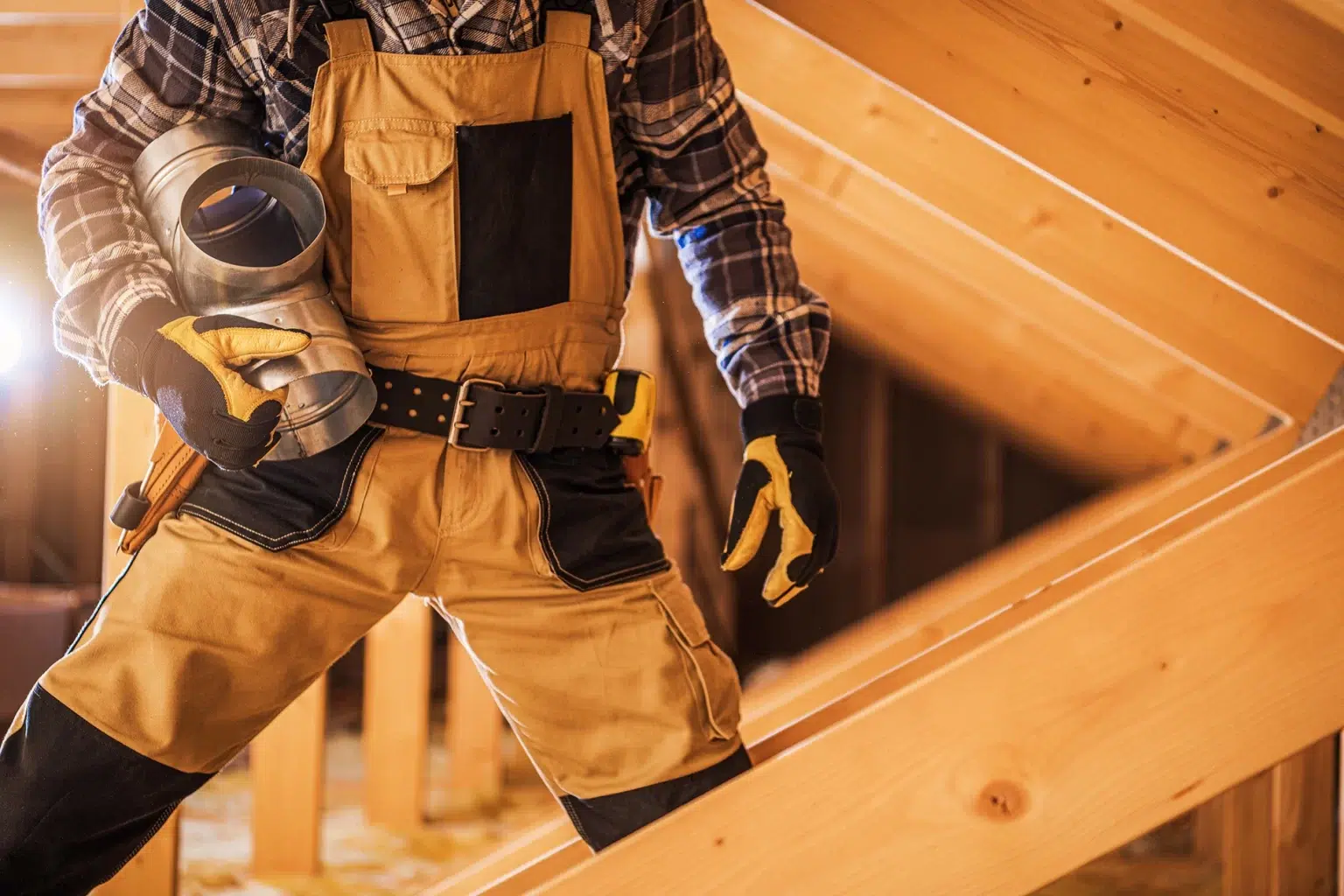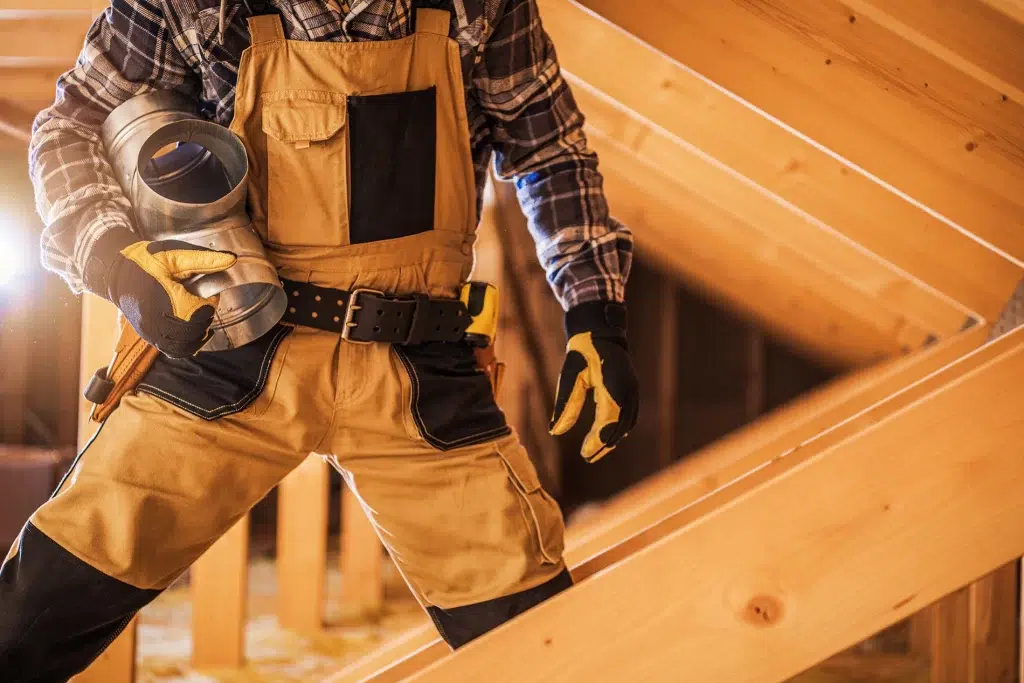The sweltering summer heat in Texas prompts homeowners to seriously consider air conditioning and insulation. However, it can be easy to overlook roof ventilation in the process.
Proper roof ventilation extends the life of your roof. It also enhances its efficiency, reduces energy costs, and keeps your home comfortable. Roof ventilation is a key aspect for keeping your Texas home cool. Let’s dive into some different types of ventilation systems and easy tips for installation and maintenance.

The Benefits of Roof Ventilation
A well-ventilated attic can significantly improve the overall comfort of your home by maintaining a more consistent indoor temperature. This reduces the strain on your air conditioning system and ensures a more comfortable living environment, even during the hottest months.
The Benefits of Roof Ventilation
Roof ventilation plays a vital role in maintaining the health of your home, especially in a hot climate like Texas. Some of the key benefits include temperature regulation, energy efficiency, prolonged roof lifespan, moisture control, and improved indoor comfort.
Proper ventilation can make a notable difference in how your home handles extreme heat, reducing strain on your cooling systems and keeping energy bills manageable.

Temperature Regulation
Proper ventilation regulates the temperature in your attic. This prevents it from becoming a heat trap. An overheated attic can cause your air conditioning system to work harder. This leads to higher energy bills and potential system failure.
Energy Efficiency
Allowing hot air to escape and cooler air to enter, roof ventilation reduces the load on your HVAC system. This improves energy efficiency, making it cheaper during the hot summer months.
Prolonged Roof Lifespan
Excessive heat can cause roofing materials to deteriorate quickly. Proper ventilation prevents the buildup of heat and moisture. This reduces the risk of damage to your shingles and the roof structure itself.
Moisture Control
Ventilation controls moisture levels in the attic. High humidity can lead to mold growth and wood rot. These unwanted injuries to your home can compromise its structural integrity. If you spot mold in your attic, you can try Concrobium or detergents. But, you may also want to call an expert for further inspection and repair.
Improved Indoor Comfort
A well ventilated attic can significantly improve the overall comfort of your home. By maintaining a more consistent indoor temperature. It reduces the strain on your air conditioning system and ensures a more comfortable living environment.
Types of Roof Ventilation Systems
Several types of roof ventilation systems are available, each with its own unique advantages. Here are some of the most common types of ventilation used in Texas roof installations, each designed to improve airflow and reduce attic heat.
Ridge Vents
Installed along the peak of the roof, ridge vents provide continuous ventilation. They are effective in allowing hot air to escape, and work best when combined with soffit vents.
Soffit Vents
Located under the eaves, soffit vents allow cool air to enter the attic. This inflow of cool air pushes hot air through ridge vents. This creates a balanced ventilation system.
Gable Vents
Gable vents are installed on the exterior walls of the attic, near the peak of the roof. Gable vents can be effective. Although, they may not provide uniform ventilation as ridge and soffit vents do.
Attic Fans
Powered by electricity or solar energy, attic fans remove hot air from the attic. They can be useful in extremely hot climates but you should use with passive ventilation systems for best results.
Turbine Vents
Turbine vents, also known as whirlybirds, use wind power to spin and create a suction effect that pulls hot air out of the attic. They are cost effective and can provide continuous ventilation as long as there is wind.
Best Ventilation for Texas Homes
Given the extreme heat in Texas, the best ventilation systems often combine several types of vents to create balanced airflow. Here are some recommended combinations to ensure effective roof ventilation in your Texas home.
Ridge and Soffit Vents
This combination is one of the most effective for providing continuous, balanced ventilation. Cool air enters through the soffit vents and hot air escapes through the ridge vents. This creates a consistent flow that regulates attic temperature.
Attic Fans with Passive Vents
Installing attic fans that work with ridge and soffit vents improves the efficiency of your system. The fans provide an extra boost in expelling hot air, especially during peak summer heat.
Solar-Powered Vents
For those looking for an eco-friendly option, solar-powered vents are an excellent choice. They operate using solar energy, reducing the reliance on the electricity grid. Installing solar panels will reduce energy consumption and cost in the long run.

Installation and Maintenance Tips
Proper installation and regular maintenance are important to ensure that your roofing ventilation works properly and efficiently. Consider the following tips for your Texas home to maintain optimal ventilation performance. Regular upkeep not only enhances the effectiveness of your ventilation system but also prevents costly repairs down the line. By following these guidelines, you can ensure your home remains comfortable and energy-efficient throughout the hot Texas summers.

Installation and Maintenance Tips
Proper installation and regular maintenance are important to ensure that your roofing ventilation works properly and efficiently. Consider the following tips for your Texas home to maintain optimal ventilation performance.
Regular upkeep not only enhances the effectiveness of your ventilation system but also prevents costly repairs down the line. By following these guidelines, you can ensure your home remains comfortable and energy-efficient throughout the hot Texas summers.
Professional Installation
While some ventilation systems can be installed as a DIY project, it’s best to hire a professional. Incorrect installation can lead to improper ventilation, and potential damage to your roof.
Regular Inspections
Conduct regular inspections of your ventilation system. Regular inspections ensure vents are not blocked by debris, insulation, or other obstructions. Clear any blockages to maintain optimal airflow.
Check for Leaks
Regular inspection for leaks around vents, especially after severe weather is crucial. Address any leaks as soon as possible to prevent water damage and mold growth.
Clean the Vents
Over time, vents can become clogged with dust, dirt, and debris. Clean them regularly to ensure that air can freely flow.
Monitor Attic Temperature
Consider installing a temperature sensor in your attic. This monitors the effectiveness of your ventilation system. This can help you identify any issues and make adjustments as needed.

Additional Considerations
In addition to the aforementioned tips, there are a few other factors to keep in mind when it comes to roof ventilation in Texas. These considerations can further enhance the effectiveness of your ventilation system. By taking a holistic approach, you can ensure that all aspects of your home’s ventilation are optimized for peak performance. Addressing these additional factors can also help tailor your ventilation strategy to the specific climate conditions and needs of your Texas home.
Additional Considerations
In addition to the aforementioned tips, there are a few other factors to keep in mind when it comes to roof ventilation in Texas. These considerations can further enhance the effectiveness of your ventilation system.
By taking a holistic approach, you can ensure that all aspects of your home’s ventilation are optimized for peak performance. Addressing these additional factors can also help tailor your ventilation strategy to the specific climate conditions and needs of your Texas home.

Building Codes and Regulations
Lorem ipsum dolor sit amet, consectetur adipiscing elit. Ut elit tellus, luctus nec ullamcorper mattis, pulvinar dapibus leo.
Insulation
Proper insulation works hand-in-hand with ventilation to keep your home energy-efficient. Make sure your attic is well-insulated to prevent heat transfer into your living space.
Roofing Material
The type of roofing material you use impacts the effectiveness of your ventilation. Some materials, like metal, can reflect more heat and work well with certain setups.
Climate Variations
Consider the specific climate conditions in your area of Texas. For instance, coastal areas have different ventilation needs compared to inland regions. Texas is a large state, which means we have varying humidity levels and wind patterns.
Final Thoughts On Roof Ventilation
In the heat of a Texas summer, proper roof ventilation is essential for a comfortable, energy efficient home. Whether you opt for ridge and soffit vents, attic fans, or a combination of systems. Ensuring correct installation and regular maintenance is key.
Investing in effective roof ventilation isn’t only about comfort. Proper roofing ventilation will protect your home and save on energy costs in the long run. You’ll want to take the time to evaluate your ventilation needs. Making the necessary improvements will allow you to enjoy a cooler, more efficient home this summer.


